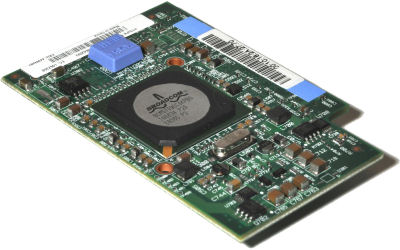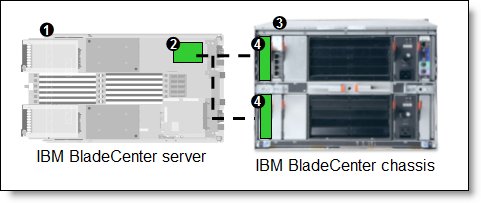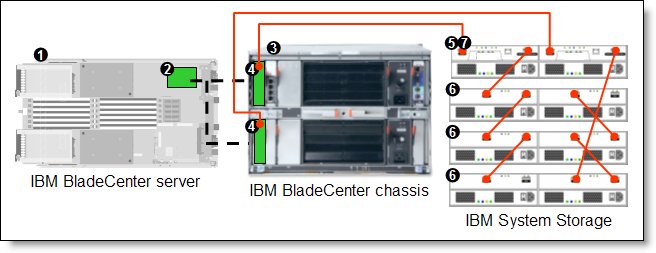Abstract
The Ethernet Expansion Card (CIOv) is an Ethernet expansion card with two 1 Gb Ethernet ports designed for BladeCenter servers with CIOv expansion slots. It is based on proven Broadcom 5709S ASIC technology and offers value added features like TCP Offload (TOE) and software-based iSCSI support for high performance.
Note: This adapter is now withdrawn from marketing
Introduction
The Ethernet Expansion Card (CIOv) is an Ethernet expansion card with two 1 Gb Ethernet ports designed for BladeCenter servers with CIOv expansion slots. It is based on proven Broadcom 5709S ASIC technology and offers value added features like TCP Offload (TOE) and software-based iSCSI support for high performance.
This card is installed into the CIOv slot of the supported blade server. It provides connections to Ethernet-compatible modules located in bays 3 and 4 of supported BladeCenter chassis. The CIOv slot is a second generation PCI Express x8 slot. A maximum of one Ethernet Expansion Card (CIOv) is supported per single-wide blade server.
The Ethernet Expansion Card (CIOv) is shown in Figure 1.

Figure 1. Ethernet Expansion Card (CIOv)
Did you know?
Today's virtualized servers require a larger number of network adapters. This adapter is a perfect fit for these environments because it can enable up to eight Ethernet ports per blade server.
The adapter is based on the PCI Express bus, which can be thought of as a high-speed serial replacement of the older technology. Its use offers many benefits including higher speeds and the ability to send and receive data at the same time.
When using the CIOv adapter, you can simultaneously use a CFFh adapter to enable more types of I/O to supported blade servers such as the HS22 when installed in the IBM BladeCenter H chassis. The innovative design of the CIOv adapter is designed to work with the CFFh adapter to support this combination workload.
Part number information
Table 1. Ordering part number and feature code
| Description | Part number | Feature code |
| Ethernet Expansion Card (CIOv) for BladeCenter | 44W4475* | 1039 |
* Withdrawn from marketing
This part number includes the following items:
- One Ethernet Expansion Card (CIOv) for BladeCenter
- Documentation package
Features
The expansion card has the following features:
- PCI Express host interface
- Broadcom BCM5709S communication module
- BladeCenter Open Fabric Manager (BOFM) support
- Connection to 1000BASE-X environments using BladeCenter Ethernet switches
- Full-duplex (FDX) capability, enabling simultaneous transmission and reception of data on the Ethernet local area network (LAN)
- Failover support
- Preboot Execution Environment (PXE) support
- Support for direct memory access (DMA)
- Wake on LAN support for both ports
Operating environment
The expansion card is supported in this environment:
- Temperature:
- 10 to 35°C (50 to 95°F) at 0 to 914 m (0 to 3,000 ft)
- 10 to 32°C (50 to 90°F) at 914 to 2,133 m (3,000 to 7,000 ft)
- Relative humidity: 8% to 80%
- Maximum altitude: 2,133 m (7,000 ft)
Supported servers and I/O modules
The Ethernet Expansion Card (CIOv) is supported in the BladeCenter servers listed in Table 2.
Table 2. Supported servers
Ethernet Expansion Card (CIOv) |
44W4475 |
N |
N |
N |
Y |
N |
N |
N |
N |
N |
N |
N |
N |
N |
N |
N
|
See ServerProven for the latest information on the expansion cards supported by each blade server type: http://www.lenovo.com/us/en/serverproven/.
CIOv expansion cards are installed in the CIOv slot in supported servers such as the HS22, as shown in green in Figure 2.

Figure 2. Location of the CIOv slot in the BladeCenter HS22
The Ethernet Expansion Card (CIOv) requires that a supported I/O module is installed in bay 3 and bay 4 of the chassis that the cards and servers are installed in. The supported I/O modules are:
- Any IBM, BNT or Cisco Ethernet Switch Module (standard form-factor switch module)
- Optical Pass-thru Module
- Copper Pass-thru Module
- Intelligent Copper Pass-thru Module
Popular configurations
This section shows two popular configurations using the Ethernet Expansion Card (CIOv).
Adding two extra Ethernet ports per blade server
Most often, the Ethernet Expansion Card (CIOv) is used to expand the number of Ethernet ports per blade to increase network bandwidth. This is shown in Figure 3.

Figure 3. The Ethernet Expansion Card (CIOv) provides two extra Ethernet ports per blade server
The components used in this configuration are listed in Table 3.
Table 3. Components used when connecting the Ethernet Expansion Card (CIOv) to external Ethernet network
| Diagram reference | Part number / Machine type | Description | Quantity |
| Varies | BladeCenter HS22 or other supported server | 1 to 14 | |
| 44W4475 | Ethernet Expansion Card (CIOv) | 1 per server | |
| Varies | BladeCenter E, BladeCenter H, or BladeCenter S* | 1 | |
| Varies | Any Ethernet-compatible switch module | 1 or 2 |
*Note: The expansion card can be installed in servers in the BladeCenter S (8886). However, by doing so you will lose the ability to connect to the BladeCenter S Disk Storage Modules (DSMs). The Ethernet expansion card will go in the place of the SAS expansion card needed to connected to the DSMs. Instead, use the 2/4 Port Ethernet Expansion Card (CFFh), part number 44W4479.
iSCSI SAN storage solution
In addition, this card can be used to connect to external iSCSI-based entry-level SAN, as shown in Figure 4.

Figure 4. BladeCenter connected to an external IBM System Storage DS3300 storage solution
The components used in this configuration are listed in Table 4.
Table 4. Components used when connecting the Ethernet Expansion Card (CIOv) to external iSCSI disk storage
| Diagram reference | Part number / Machine type | Description | Quantity |
| Varies | BladeCenter HS22 or other supported server | 1 to 14 | |
| 44W4475 | Ethernet Expansion Card (CIOv) | 1 per server | |
| Varies | BladeCenter E, BladeCenter H, or BladeCenter S* | 1 | |
| Varies | Any Ethernet-compatible switch module | 1 or 2 | |
| 1726-31X or 1726-32X | IBM System Storage DS3300 (Single or Dual Controller) | 1 | |
| 1727 | Optional IBM System Storage EXP3000 (Single or Dual ESM) | 1 to 3 | |
| 39R6536 | DS3000 Partition Expansion License | 1 |
*Note: The expansion card can be installed in servers in the BladeCenter S (8886). However, by doing so you will lose the ability to connect to the BladeCenter S Disk Storage Modules (DSMs). The Ethernet expansion card will go in the place of the SAS expansion card needed to connected to the DSMs. Instead, use the 2/4 Port Ethernet Expansion Card (CFFh), part number 44W4479.
This configuration will also require cabling between the chassis and the storage server and between the storage server and expansion units. (The cable part numbers are not listed in Table 4.)
Supported operating systems
The following operating systems support the expansion card:
- Microsoft Windows Server 2003, Web Edition
- Microsoft Windows Server 2003/2003 R2, Enterprise Edition
- Microsoft Windows Server 2003/2003 R2, Enterprise x64 Edition
- Microsoft Windows Server 2003/2003 R2, Standard Edition
- Microsoft Windows Server 2003/2003 R2, Standard x64 Edition
- Microsoft Windows Server 2008, Enterprise x64 Edition
- Microsoft Windows Server 2008, Enterprise x86 Edition
- Microsoft Windows Server 2008, Standard x64 Edition
- Microsoft Windows Server 2008, Standard x86 Edition
- Microsoft Windows Server 2008, Web x64 Edition
- Microsoft Windows Server 2008, Web x86 Edition
- Microsoft Windows Small Business Server 2003/2003 R2 Premium Edition
- Microsoft Windows Small Business Server 2003/2003 R2 Standard Edition
- Red Hat Enterprise Linux 5 Server Edition
- Red Hat Enterprise Linux 5 Server with Xen x64 Edition
- Red Hat Enterprise Linux 5 Server x64 Edition
- SUSE Linux Enterprise Server 10 for AMD64/EM64T
- SUSE Linux Enterprise Server 10 for x86
- SUSE Linux Enterprise Server 10 with Xen for AMD64/EM64T
- SUSE Linux Enterprise Server 10 with Xen for x86
See ServerProven for the latest information on the specific versions and service packs supported: http://www.lenovo.com/us/en/serverproven/. Select the blade server and then select the expansion card to see the supported operating systems.
Related product families
Product families related to this document are the following:
Trademarks
Lenovo and the Lenovo logo are trademarks or registered trademarks of Lenovo in the United States, other countries, or both. A current list of Lenovo trademarks is available on the Web at https://www.lenovo.com/us/en/legal/copytrade/.
The following terms are trademarks of Lenovo in the United States, other countries, or both:
Lenovo®
BladeCenter®
ServerProven®
The following terms are trademarks of other companies:
Linux® is the trademark of Linus Torvalds in the U.S. and other countries.
Microsoft®, Windows Server®, and Windows® are trademarks of Microsoft Corporation in the United States, other countries, or both.
IBM® and ibm.com® are trademarks of IBM in the United States, other countries, or both.
Other company, product, or service names may be trademarks or service marks of others.
